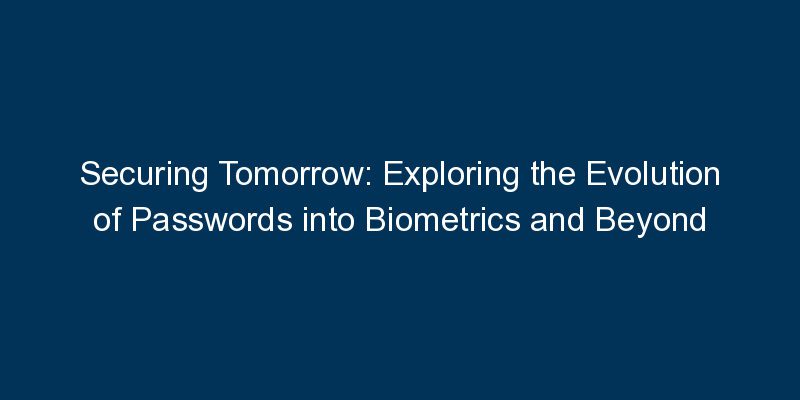In the ever-evolving landscape of cybersecurity, the traditional password is undergoing a transformation. As technology advances, so does the need for more secure and user-friendly authentication methods. This blog delves into the future of passwords, exploring the rise of biometrics and other innovative authentication technologies that are reshaping the way we protect our digital identities.
The Limitations of Traditional Passwords
Traditional passwords, consisting of alphanumeric combinations, have long been the standard for securing digital accounts. However, they come with inherent vulnerabilities. Users often resort to easily guessable passwords or reuse them across multiple platforms, exposing themselves to the risk of unauthorized access. Moreover, the complexity requirements for passwords can lead to forgetfulness, resulting in frequent password resets.
Biometrics: A Shift Towards Personalized Authentication
Biometric authentication marks a significant departure from traditional passwords. Leveraging unique physical and behavioral characteristics, biometrics offer a more secure and personalized method of identity verification. Common biometric modalities include fingerprint recognition, facial recognition, iris scanning, and voice recognition. These technologies provide a seamless and efficient user experience while enhancing security.
Fingerprint Recognition: Touch of Security
Fingerprint recognition, long associated with forensic investigations, has found widespread application in digital security. Devices equipped with fingerprint scanners allow users to unlock their smartphones, laptops, or access secure applications with a simple touch. The uniqueness of each fingerprint ensures a high level of security, and the convenience of touch-based authentication has made it a popular choice.
Facial Recognition: Your Face as the Key
Facial recognition technology has gained prominence in recent years, enabling users to unlock devices or access services simply by looking at the camera. The sophisticated algorithms behind facial recognition analyze facial features and contours to create a unique biometric profile. While convenient, concerns about privacy and the potential for misuse have spurred ongoing discussions around ethical implementations.
Iris Scanning: Unveiling a New Perspective
Iris scanning takes biometric authentication to a new level by capturing the intricate patterns of the iris, the colored part of the eye. This method offers a high level of accuracy and is difficult to forge. Iris scanners are employed in various secure environments, providing access control with a quick and contactless verification process.
Voice Recognition: The Sound of Security
Voice recognition technology relies on the unique vocal characteristics of individuals to verify their identity. From unlocking smartphones to authenticating transactions, voice recognition adds an auditory layer to biometric authentication. However, challenges such as environmental noise and the potential for voice recordings pose considerations for its widespread adoption.
Beyond Biometrics: Innovative Authentication Technologies
As technology continues to advance, new and innovative authentication methods are emerging. Some of these include:
- Behavioral Biometrics: Analyzing patterns such as typing speed, mouse movements, and device usage behavior to create a unique user profile.
- Token-based Authentication: Utilizing physical or virtual tokens, such as security keys or mobile authentication apps, to verify user identity.
- DNA-based Authentication: Exploring the potential of using DNA as a unique identifier for ultra-secure authentication, although this concept is still in its early stages.
Challenges and Considerations
While biometrics and other innovative authentication methods offer enhanced security and user convenience, challenges persist. Privacy concerns, potential data breaches, and the need for standardized frameworks are critical considerations in the widespread adoption of these technologies. Striking the right balance between security and user experience remains an ongoing challenge for developers and cybersecurity experts.
Conclusion
The future of passwords is undoubtedly evolving towards more secure, user-friendly, and innovative authentication methods. Biometrics, with its various modalities, has already made significant inroads into mainstream digital security. As we look ahead, the integration of behavioral biometrics, token-based authentication, and even DNA-based verification may become more prevalent. While these advancements hold great promise, it is crucial to address the challenges and ethical considerations associated with these technologies. The future of passwords is not just about securing access; it is about redefining how we prove our digital identities in a world where security and convenience go hand in hand. Embracing these changes ensures a safer and more seamless digital experience for users worldwide.



















Comments